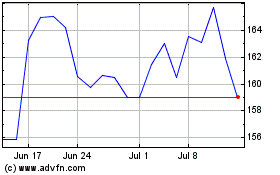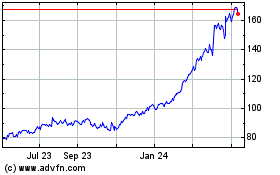FAA Orders Inspections of Engines on Most Airbus A380s
October 12 2017 - 11:45PM
Dow Jones News
By Andy Pasztor
U.S. air-safety regulators have issued an emergency order
requiring airlines to inspect engines on roughly 120 Airbus A380
superjumbo jets world-wide, prompted by an engine that violently
broke apart during an Air France flight at the end of
September.
The safety directive issued Thursday by the Federal Aviation
Administration covers all engines manufactured for Airbus SE A380s
by a joint venture comprising General Electric Co. and United
Technologies Corp.'s Pratt & Whitney unit. The partnership
supplies engines for roughly 60 percent of the global A380 fleet,
with Emirates Airline operating the majority of the affected
four-engine, double-decker aircraft.
The move by the FAA, which certified the engine as did European
regulators 10 years ago, requires inspections to start as quickly
as two weeks, depending on the number of trips they have flown. The
directive follows a nonbinding service bulletin issued by the
engine alliance.
On September 30, one engine of an Air France A380 cruising at
37,000 feet over Greenland suffered a major failure with parts
flying off and damaging nearby structures. The plane landed safely
and nobody was injured, but the circumstances prompted an intense
international probe. Pictures showed the guts of the engine
exposed, with large sections in front missing.
It is highly unusual for an engine to suffer such a serious
malfunction as breaking apart in flight. Portions of the cowling,
or inlet portion, and nearby rotating sections separated from the
rest of the engine so violently that the sequence of events was
akin to an explosion. According to the FAA, the fan hub on a
"relatively high cycle" engine suddenly failed, a problem that can
damage the engine and part of the plane.
Some large fragments were found on the ground in Greenland,
while others were retrieved on the runway after the plane, carrying
more than 520 people on a flight to Los Angeles from Paris, made an
emergency landing at Goose Bay, Canada.
Portions of the pylon attaching the engine to the right wing
also were damaged. The pilots declared a "Mayday" and fire crews
checked for leaks as soon as the jet pulled off the runway.
French investigators have been announcing the status of the
probe, which includes Airbus officials and engine experts as well
as U.S. and Canadian government investigators. The damaged engine
is slated to be shipped to General Electric's overhaul facilities
in Wales for detailed analysis.
But in the interim, the FAA wants operators to inspect front fan
hubs -- disks that hold rotating blades -- for possible defects or
damage. The manufacturer said the checks take roughly two hours and
can be done without removing engines from aircraft.
Responding to questions for the alliance, a General Electric
spokesman said in an email that the inspections are precautionary
and "a root cause has not been established." The rest of the GP7200
engine fleet "powers the A380 around the clock," according to the
statement, and "we aren't aware of any issues" that would threaten
flight safety.
As part of its inspection mandate, the FAA said it was taking
interim action and "may consider additional rule-making" if
warranted.
The same family of engines experienced an unrelated safety
problem five years ago, prompting a previous FAA airworthiness
directive.
In November 2012, an Emirates A380 departing Sydney had an
engine shut down on its own at about 9,000 feet. The plane returned
to the airport without any passengers injured. But a subsequent
investigation by Australian authorities revealed that unexpectedly
high temperatures stemming from a poorly designed nozzle resulted
in significant internal damage.
Two years earlier, the engine manufacturer had issued a service
bulletin calling for a replacement of the suspect parts with new,
more durable components. Following the incident, the FAA issued a
mandatory directive requiring inspections and removal of damaged
parts.
Write to Andy Pasztor at andy.pasztor@wsj.com
(END) Dow Jones Newswires
October 12, 2017 23:30 ET (03:30 GMT)
Copyright (c) 2017 Dow Jones & Company, Inc.
GE Aerospace (NYSE:GE)
Historical Stock Chart
From Mar 2024 to Apr 2024

GE Aerospace (NYSE:GE)
Historical Stock Chart
From Apr 2023 to Apr 2024
